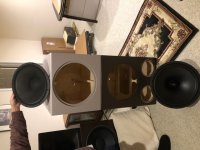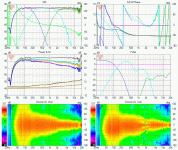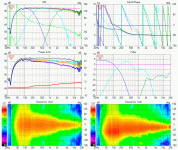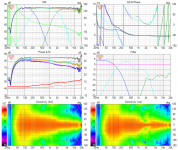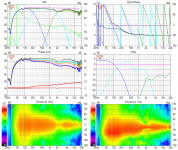That Tannoy looks like a nice box, hadn't seen it before.
And yep, seen/heard & done similar....
Here's a 15" B&C coax i made with the same idea, 4 reflex ports in corners.
The foamboard horn ring was about trying to get some extra horn umph.....
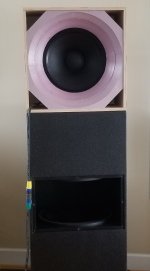
.....horn ring didn't work and i got rid of it in favor of a flat baffle.
And then painted and put a screen grill on the box, to go with a pair of 18fh500 reflex subs. Stuck it all up in dock rafters for party by the water. 😀
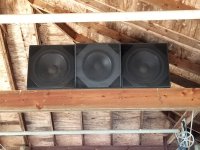
And yep, seen/heard & done similar....
Here's a 15" B&C coax i made with the same idea, 4 reflex ports in corners.
The foamboard horn ring was about trying to get some extra horn umph.....

.....horn ring didn't work and i got rid of it in favor of a flat baffle.
And then painted and put a screen grill on the box, to go with a pair of 18fh500 reflex subs. Stuck it all up in dock rafters for party by the water. 😀

Coax top
https://www.diyaudio.com/forums/attachment.php?attachmentid=991009&stc=1&d=1634487868
Top is just primed. Vortex15.
Bottom is AETD15S.
Not completed yet.
using a Coaxial top, results in an interesting amount of sd.
https://www.diyaudio.com/forums/attachment.php?attachmentid=991009&stc=1&d=1634487868
Top is just primed. Vortex15.
Bottom is AETD15S.
Not completed yet.
Attachments
The Tannoy vx15 uses a 2" HF diaphragm crossing to a more sensitive 15" cone woofer "waveguide", the Kingdom model uses a 3" HF diaphragm crossing to a less sensitive 12" sealed cone "waveguide" with a tweeter above. A 3" is capable of about 7dB more output at 700 Hz than the 2", hence the higher 1300 Hz crossover for the 15".Using the knowledge I've picked up in this thread, and applying it to the idea of using a Coaxial top, results in an interesting amount of sd.
I noticed that with the Kingdom model the Tweeter is being crossed at 700hz... Its likely that the same potential is true for the Tweeter in the VX line. From there one would cross over to the low woofer at what?
Sensitivity is high for both the tweeter and mid woofer of the Tannoy vx15
The VX is a cheaper choice with more compromises made.
The 120 Hz crossover point chosen between the Kingdom's sealed 12" and it's 15" low woofer seems reasonable.
Sensitivity, efficiency, and directivity of a coaxial of this size can be comparable to that of compression drivers with horns or waveguides of the same diameter...
Mark and Paul have found themselves visiting the coaxial approach, maybe they can give us some personal opinion on the matter
I'm always looking for a spec to criticize in order to predict the actual sonic experience. In this instance I suspect Sensitivity to be a factor.
"The foamboard horn ring was about trying to get some extra horn umph" "horn ring didn't work and i got rid of it in favor of a flat baffle" - It would seem that if waveguides were as effective as horns, that you would of been successful here. I think effects of sensitivity is the missing factor you describe as "umph" What did you conclude on the source of the lack of "umph"???.....
weltersys - For the MTM I'm talking about, A 300hz xo seems more appropriate don't you think? Or maybe higher or as high as possible? The XO advantage with coaxial is the great improvement had with FIR. Do you have any insight into why Marks experience lacked "horn omph"?
Mark and Paul have found themselves visiting the coaxial approach, maybe they can give us some personal opinion on the matter
I'm always looking for a spec to criticize in order to predict the actual sonic experience. In this instance I suspect Sensitivity to be a factor.
So it didn't become your main system.Stuck it all up in dock rafters for party by the water.
"The foamboard horn ring was about trying to get some extra horn umph" "horn ring didn't work and i got rid of it in favor of a flat baffle" - It would seem that if waveguides were as effective as horns, that you would of been successful here. I think effects of sensitivity is the missing factor you describe as "umph" What did you conclude on the source of the lack of "umph"???.....
weltersys - For the MTM I'm talking about, A 300hz xo seems more appropriate don't you think? Or maybe higher or as high as possible? The XO advantage with coaxial is the great improvement had with FIR. Do you have any insight into why Marks experience lacked "horn omph"?
Last edited:
This polar is pretty much like the polars of some Horns and waveguides I've seen. The mass missing in the center helps keep the cone light. Comparing this to a compression driver +waveguide/horn crossed to a 15" woofer.... If one could get the coaxial as smooth as +/- 2db or so...who does the Coaxial seem to be "missing" something. The tweeter is a waveguided compression driver. 108db sensitivity for the tweeter and 100db sensitivity.....I'm guessing almost identical situation for the common 15" woofer + waveguided compression driver situation....
The CSD is in question. I am not sure why this isn't "The solution" for a lot more people. I would think its quality of the tweeter but it would seem that this would be sorted by now.
Attachments
maybe they can give us some personal opinion on the matter...I'm always looking for a spec to criticize
We hear what we expect to hear
We hear what we expect to hear | EurekAlert!
We hear what we expect to hear | Audio Science Review (ASR) Forum
^^ Difference with coaxial and separate devices, in very root level, is that in a coaxial the woofer is a horn and the horn is a woofer. This means either or both has compromises compared to a situation where woofer is only a woofer and horn is only a horn in which case both can be optimized better for their own purpose. Very theoretical, but this is essentially the issue with coaxials. Some coaxials are better some way and others the other way, but they are never going to match separate devices in performance on their own. But, as always you have to consider the system performance as a whole.
When it is better to have coaxial system than one with separate devices? From top of my head, the coaxial has uniform sound to any off-axis direction where a system with separate horn and woofer can have uniform sound on any one plane only and all others have different (because the drivers are not coincident). Uniform sound to any direction would be nice in a stage floor monitor where the listener can be at any direction or in a near field listening situation when the speaker is relatively big compared to listening distance. But, basically in any confined listening position situation it is often possible to use system with separate woofer and horn to cover the whole listening area rather nicely and reap the benefits of separate optimal woofer and horn.
Sound from different sources can and will share same space because the sound waves superimpose (as it is basically pressure) but the sound sources them selves cannot share space because they are physical objects. Still, sound has physical size which relates how it interacts with physical objects. For this reason loudspeaker systems will always have compromises: Either the combining is compromised with non-coincident sound sources which makes a localized listening area or the source is compromised having the various size transducers/sources distract each other.
So, if a coaxial system was not the best solution always some times it is. It is crucial to understand what kind of system would suit best a given situation to get best possible sound in that particular situation.
When it is better to have coaxial system than one with separate devices? From top of my head, the coaxial has uniform sound to any off-axis direction where a system with separate horn and woofer can have uniform sound on any one plane only and all others have different (because the drivers are not coincident). Uniform sound to any direction would be nice in a stage floor monitor where the listener can be at any direction or in a near field listening situation when the speaker is relatively big compared to listening distance. But, basically in any confined listening position situation it is often possible to use system with separate woofer and horn to cover the whole listening area rather nicely and reap the benefits of separate optimal woofer and horn.
Sound from different sources can and will share same space because the sound waves superimpose (as it is basically pressure) but the sound sources them selves cannot share space because they are physical objects. Still, sound has physical size which relates how it interacts with physical objects. For this reason loudspeaker systems will always have compromises: Either the combining is compromised with non-coincident sound sources which makes a localized listening area or the source is compromised having the various size transducers/sources distract each other.
So, if a coaxial system was not the best solution always some times it is. It is crucial to understand what kind of system would suit best a given situation to get best possible sound in that particular situation.
Last edited:
Laurie Fincham made a comment in one of the videos he did with Erin that 5" was found to be the best size for coaxial hifi drivers as once the cone got bigger the off axis became to difficult to manage. I don't remember which video or where unfortunately. Andrew Jones has continued this same sort of physical design for Kef, Elac and Tad. genelec very similar but they use the cabinet as a waveguide extension.
BMS 10C262 coaxial build
Having experience with this driver I don’t know if that still holds true in general ☝��
Having experience with this driver I don’t know if that still holds true in general ☝��
Yeah, with modern manufacturing techniques the woofer and baffle can be profiled to perform as a nice waveguide. Not sure what is the situation with throat, at least compression driver back of the system would have very long throat section through the woofer motor assembly which might dictate a dome tweeter up front gives better performance than a compression driver on the back (directivity wise). Then there would be SPL limit but for home use there would still be plenty enough. Checkout the examples fluid mentioned, pretty good.
Another thing to improve coaxial system is to use separate woofer for lows to keep "the horn" excursion minimum 🙂
Another thing to improve coaxial system is to use separate woofer for lows to keep "the horn" excursion minimum 🙂
Last edited:
His comment doesn't invalidate your experience or vice versa. Tannoy Westminster's and other large coaxials are liked by many. It was also made most likely with a dome tweeter in mind rather than a compression driver but a large woofer does not make a great waveguide. But that doesn't mean that it can't be functional or sound good either.BMS 10C262 coaxial build
Having experience with this driver I don’t know if that still holds true in general ☝��
And I never knowingly said that it did. Essentially what I wanted to put forth is be careful with generalizations, not much different from what you’re saying.
The big challenge for me in optimizing this particular coax has been to find the acoustic centers of the drivers. FIR has been absolutely essential in taming this particular beast but having done that you will have a driver that images really well.
The big challenge for me in optimizing this particular coax has been to find the acoustic centers of the drivers. FIR has been absolutely essential in taming this particular beast but having done that you will have a driver that images really well.
(semi) Dual channel measurement would have the relative time difference included. Check out VituixCAD and its documents for easy future projects 😉
Last edited:
For some circumstances there wouldn't be too much difference between coaxial and separate devices, at least it looks like so with a quick simulator test. Attached is a GIF showing real system (simulation based on measured data) and a what if situation where the waveguide is brought coincident to the mid range in the simulator. Not much difference on the design "plane". Based on the mild difference on the DI and early reflections DI I'd say at least some non coincident systems can approximate sound of a coincident system pretty well at listening position including the effects of the room. If the listening height varies the sound would be different for a coincident and non coincident, but for planned listening position there really is not much difference which to use. I'd use the non coincident if it allows better set of compromises on the woofer and on the waveguide.
The DI and early reflections DI are remarkably similar. The c-c here is crazy 1.8wl, ~30cm at ~2kHz. Anything less the difference is far greater around xo, until ~< 1/3wl they start to look like the coincident case again.
Anyway, just an example that in some cases both should sound equally fine. I haven't yet tested if the holes near vertical 0 axis are audible in far field at living room conditions. The in room response (orange trace) says not much difference especially if the xo region was EQ:d a bit which we could very well do since the DI is very similar on both.
The DI and early reflections DI are remarkably similar. The c-c here is crazy 1.8wl, ~30cm at ~2kHz. Anything less the difference is far greater around xo, until ~< 1/3wl they start to look like the coincident case again.
Anyway, just an example that in some cases both should sound equally fine. I haven't yet tested if the holes near vertical 0 axis are audible in far field at living room conditions. The in room response (orange trace) says not much difference especially if the xo region was EQ:d a bit which we could very well do since the DI is very similar on both.
Attachments
Last edited:
For completeness sake here is GIF of the same situation but inspection point is 90cm above tweeter height approximating stand up listening position instead of sitting down on axis. Now the ear is smack dap in the dip and the difference between non-coincident to coincident is apparent.
A mere "BBC dip" so the sound is actually better!?😀 looking at the phase and group delay there should be some weird phasey sound at the xo, unless the early reflections mask it. Simulations are interesting.
A mere "BBC dip" so the sound is actually better!?😀 looking at the phase and group delay there should be some weird phasey sound at the xo, unless the early reflections mask it. Simulations are interesting.
Attachments
Last edited:
Here is normal c-c spacing, as close as possible which is in this case ~1wl. No GIF this time, would have to make two 🙂 The stand up listening position doesn't have as bad dip in the response since the main lobe is wider and the head doesn't quite end up at a vertical null. But at the same time the vertical early reflections have more difference to the coincident case than in the previous example. Visible even without the overlay like in the previous images since I forgot to add it, sorry.
Anyway, these demonstrations are at core of the compromise. It is possible to approximate response of a coincident system with non-coincident system but the listening spot gets ever smaller where this is achieved. Expense is worse response outside the listening spot. However we are able to use two separate device optimized for their own (woofer and horn) and achieve that much better sound for the intended listening spot (plane). What ever that better is. Remember to use the best there is to better a coaxial system! One should remember what the listening situation would be to be able to select the most suitable system. I suspect all of the examples would sound equally fine at home for "critical listening" at the sofa and for background music during the chores. If I had time to stand around the listening spot doing nothing then there would be perhaps easily spotted differences.
Attachments:
1. sitting
2. standing
Anyway, these demonstrations are at core of the compromise. It is possible to approximate response of a coincident system with non-coincident system but the listening spot gets ever smaller where this is achieved. Expense is worse response outside the listening spot. However we are able to use two separate device optimized for their own (woofer and horn) and achieve that much better sound for the intended listening spot (plane). What ever that better is. Remember to use the best there is to better a coaxial system! One should remember what the listening situation would be to be able to select the most suitable system. I suspect all of the examples would sound equally fine at home for "critical listening" at the sofa and for background music during the chores. If I had time to stand around the listening spot doing nothing then there would be perhaps easily spotted differences.
Attachments:
1. sitting
2. standing
Attachments
Last edited:
I’m using VCAD, and I was talking about the acoustical center in the Z plane.
This is the tricky bit to determine for the exact frequency of the crossover since it seems to
shift with frequency and does not adhere to the physical properties of the driver.
This is the tricky bit to determine for the exact frequency of the crossover since it seems to
shift with frequency and does not adhere to the physical properties of the driver.
Isn't it all in the data? if you do measure both without moving the mic or DUT, the baffle as reference plane/rotating axis, the phase information all should be there in the impulse responses.
Convert the measured impulse responses to frequency responses using same windowing. Using VCAD IR to FR tool this would be done using the on-axis measurement of the tweeter to find suitable window. Set the window start a bit before the peak so that the woofer peak that probably arrives earlier fits in the window as well. Now export the tweeter files. Then load in the woofer files but don't touch anything else, export them using same settings you just used with the tweeter. The Z coordinate would be left 0 in the driver settings if you do it like this because the Z information is now included in the measurement data.
I don't know what exact difference of acoustic centers would tell or why would you need to know it other than patching in the Z coordinate in case you lost the timing data in the measurements. Using calculated minimum phase (losing the measured phase) is not advised because it gets tricky and not as accurate.
Convert the measured impulse responses to frequency responses using same windowing. Using VCAD IR to FR tool this would be done using the on-axis measurement of the tweeter to find suitable window. Set the window start a bit before the peak so that the woofer peak that probably arrives earlier fits in the window as well. Now export the tweeter files. Then load in the woofer files but don't touch anything else, export them using same settings you just used with the tweeter. The Z coordinate would be left 0 in the driver settings if you do it like this because the Z information is now included in the measurement data.
I don't know what exact difference of acoustic centers would tell or why would you need to know it other than patching in the Z coordinate in case you lost the timing data in the measurements. Using calculated minimum phase (losing the measured phase) is not advised because it gets tricky and not as accurate.
Last edited:
Sensitivity, efficiency, and directivity of a coaxial of this size can be comparable to that of compression drivers with horns or waveguides of the same diameter...
Mark and Paul have found themselves visiting the coaxial approach, maybe they can give us some personal opinion on the matter
I'm always looking for a spec to criticize in order to predict the actual sonic experience. In this instance I suspect Sensitivity to be a factor.
My 2c take on coaxes is that a vibrating cone doesn't make the worlds best waveguide. And that is why the smaller coaxes shine the brightest.
Maybe CSD is a measurement that could shows this.. dunno...never bother with CSD.
I saw that when corrected, frequency and phase response had a lot more 1/48th fuzz, than i see on commercial horns like the xt1464 on top of a 12" cone, or between two 12"s in MTM fashion. This fuzz was all through the coax's spectrum, so it appears the CD messes with the coax cone too.
Imo, the quality of the coax has to the prime factor behind its SQ, and i doubt you will ever find that via measurement without listening.
Can't see how sensitivity fits in at all...????
So it didn't become your main system.
"The foamboard horn ring was about trying to get some extra horn umph" "horn ring didn't work and i got rid of it in favor of a flat baffle" - It would seem that if waveguides were as effective as horns, that you would of been successful here. I think effects of sensitivity is the missing factor you describe as "umph" What did you conclude on the source of the lack of "umph"???.....
I was trying to copy what DSL does with their SM-80, a very popular box used for small to medium live-sound and DJ gigs. It uses a 12" B&C coax mounted in a molded horn.
When i showed them what i had built and was attempting, I was told it even took them a few tries to get their molding working right.
As I had already seen the coax wasn't going to meet my accustomed level of SQ, I just ditched continuing the horn effort.
All that said, it sounds great down on the dock 🙂
(Btw, the 18FH500's make for really nice single 18" subs...)
- Home
- Loudspeakers
- Multi-Way
- Is it possible to cover the whole spectrum, high SPL, low distortion with a 2-way?
